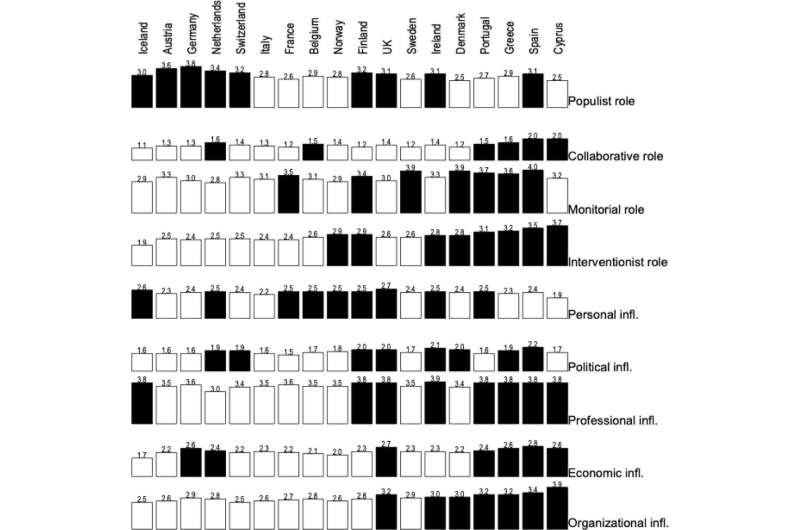Indexes for perceived roles and influences for European journalistsComments: Bertin graph with country means for perceived roles and influences. 18 countries, N = 10,254. Black categories are above-average for the variable. Credit: Nordicom Review (2021). DOI: 10.2478/nor-2021-0034
Swedish and Danish journalists describe their role as monitorial to a greater extent than journalists from other Nordic countries. Journalists from Norway and Iceland state they have the least experience of political influence and thus differ from Finnish journalists. This is shown by a new comparative study published by Nordicom at the University of Gothenburg.
In a new study, researchers examine the similarities and differences in Nordic journalists' perceptions of the role of journalists and different kinds of influence on journalistic work. They also compare the Nordic perceptions with journalists in the rest of Europe. The study is based on survey data from the Worlds of Journalism Study, which is the largest comparative journalism study ever conducted. The study covers 67 countries around the world, including all Nordic countries.
"We have directly comparable data from Nordic and European countries, which is rare. When we combine analysis of these data with our concept of journalistic style, we can present a more holistic and nuanced view of Nordic journalists' professional values and working conditions than previous studies", says Jari Väliverronen, researcher in journalism at Tampere University and one of the researchers behind the study.
Many similarities between Sweden and Denmark
Danish and Swedish journalists are generally the most similar in the study and are distinguished by a strong identification with the monitorial role of journalists.
"Danish and Swedish journalists consider to a greater extent their monitorial role in relation to, for example, politics to be important, but at the same time, they also emphasize the importance of objectivity", says Jan Fredrik Hovden, professor of media studies at the University of Bergen and the other researcher behind the study.
The main difference between the countries is the experience of external influences. The Swedes experience the strongest financial impact on their work, while the Danes feel they are most influenced by organizational factors, such as strong pressure from the newsrooms.
In a European context, journalists from the Nordic countries are relatively similar to each other, with comparatively low levels of perceived political and economic influence.
"The fact that the Nordic countries are relatively similar in a European comparison indicates that national media systems have a strong impact on journalists' professional roles and perceived influences. Within the Nordic region, on the other hand, there are clear differences, and several different journalistic styles emerge", says Väliverronen.
The most important differences within the Nordic region are related to journalists' relations to the political field, on one hand, and the strength of their perceived editorial autonomy and external influences, on the other. Norwegian and Icelandic journalists distance themselves to a greater extent from politics and have a more market-oriented style; this is especially true for Icelandic journalists. Finnish journalists, on the other hand, appear to be more oriented towards their local community, and also feel most strongly influenced by politics, compared with the other Nordic countries.
"Nordic journalists' conceptual roles and perceived influences. A European and inter-Nordic comparison," by Jan Fredrik Hovden and Jari Väliverronen, is published in the scientific journal Nordicom Review, issued by Nordicom at the University of Gothenburg.
More information: Jan Fredrik Hovden et al, Nordic journalists' conceptual roles and perceived influences, Nordicom Review (2021). DOI: 10.2478/nor-2021-0034
Provided by University of Gothenburg
























